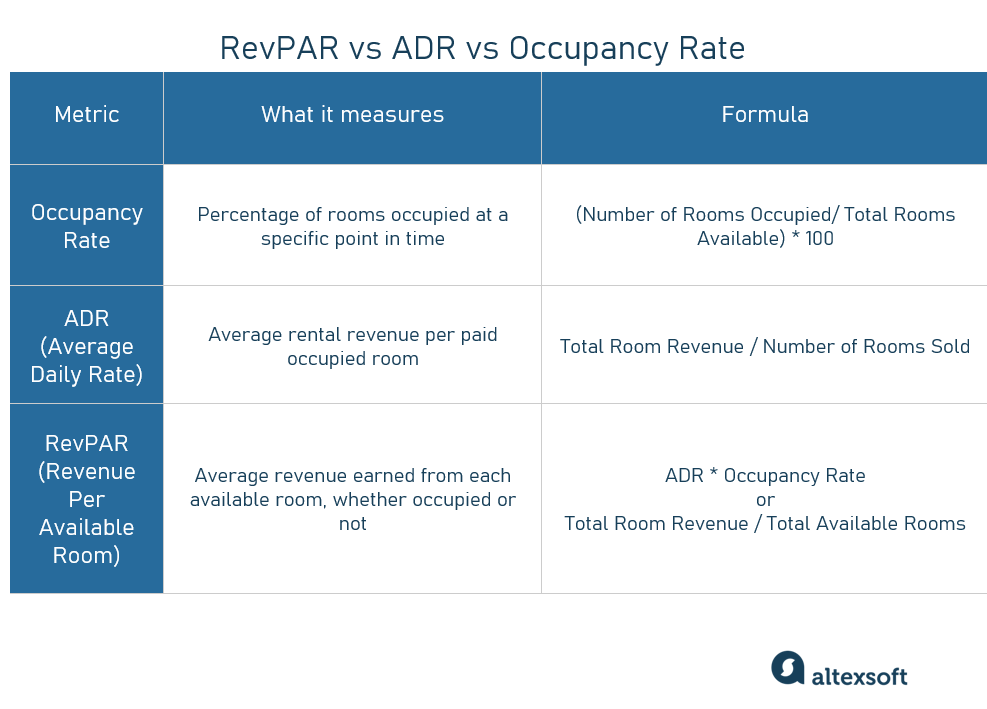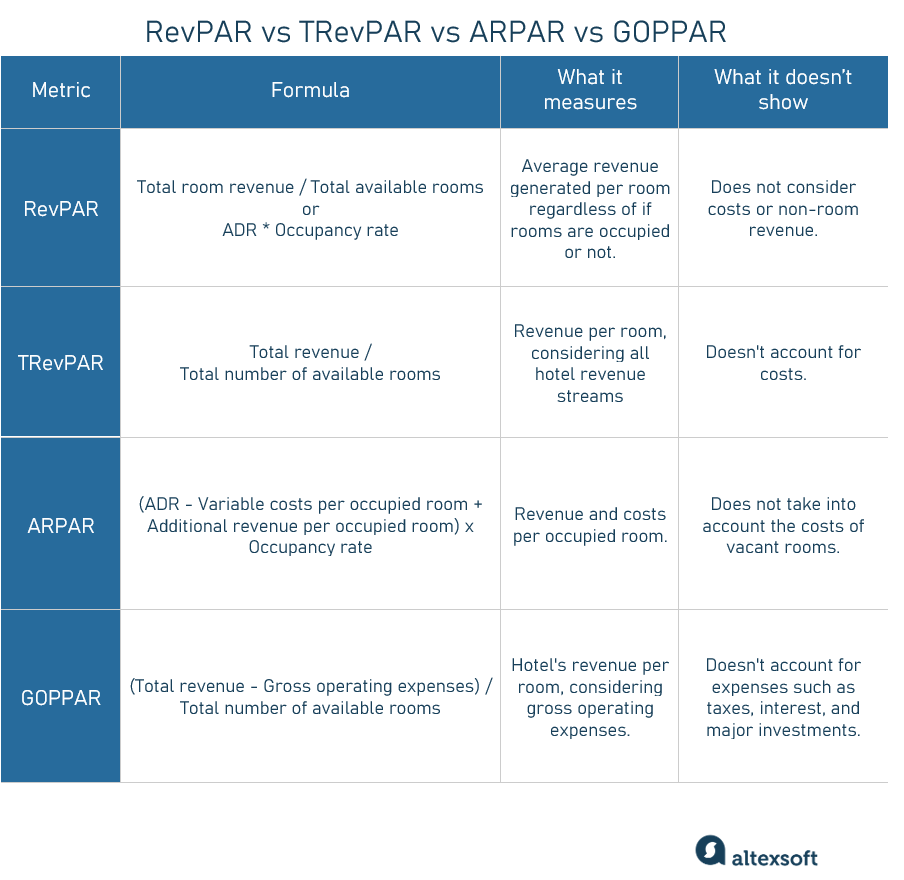The hospitality industry is an intensely competitive arena where properties constantly strive for maximum revenue generation and growth. Revenue Per Available Room, or RevPAR, has emerged as a crucial key performance indicator (KPI) for assessing a hotel's financial well-being and prosperity. This significant metric enables hotel owners to evaluate their property's performance by considering both occupancy rates and average daily rates (ADR).
In this article, we will probe the concept of RevPAR, its benefits and drawbacks, and how it compares with other KPIs. Additionally, we will examine how cutting-edge technologies, specifically machine learning (ML) and artificial intelligence (AI), are revolutionizing the way hoteliers optimize their revenue management strategies to achieve higher RevPAR.
What is RevPAR in hotel revenue management?
Revenue Per Available Room, or RevPAR, is one of the key performance metrics in the hotel industry that assesses a property's revenue-generating capabilities. RevPAR offers valuable insights into a hotel's ability to fill and price its rooms. This metric provides a standardized measure of a hotel's performance, allowing for comparisons across different properties and periods, ultimately helping hoteliers make informed decisions about pricing, marketing, and overall revenue management strategies.
RevPAR formula: How to calculate RevPAR
To calculate RevPAR, choose from two straightforward mathematical formulas.
- Divide the hotel's total room revenue by the total number of available rooms during the evaluation period: RevPAR = Total room revenue / Total available rooms.
- Multiply the hotel's average daily rate (ADR) by its occupancy rate: RevPAR = ADR * Occupancy rate.
Both methods produce identical outcomes, and the selection is usually based on the available data.
RevPAR examples
Here are three examples illustrating how to calculate RevPAR for hotels of different sizes. In each case, both calculation methods are used to demonstrate their consistency.
Example 1: Small Boutique Hotel. Imagine a boutique hotel with 20 rooms that sells 15 rooms at an ADR of $150 on a specific day.
- Method 1: RevPAR = Total room revenue / Total available rooms = ($150 * 15) / 20 = $112.5
- Method 2: RevPAR = ADR * Occupancy rate = $150 * (15/20) = $112.5
The boutique hotel's RevPAR is $112.5.
Example 2: Medium-Sized Hotel. Consider a medium-sized hotel with 100 rooms that sells 70 rooms at an ADR of $120 on a particular day.
- Method 1: RevPAR = Total room revenue / Total available rooms = ($120 * 70) / 100 = $84
- Method 2: RevPAR = ADR * Occupancy rate = $120 * (70/100) = $84
The medium-sized hotel's RevPAR is $84.
Example 3: Large Hotel. Last, picture a large hotel with 500 rooms that sells 350 at an ADR of $200 on a given day.
- Method 1: RevPAR = Total room revenue / Total available rooms = ($200 * 350) / 500 = $140
- Method 2: RevPAR = ADR * Occupancy rate = $200 * (350/500) = $140
The large hotel's RevPAR is $140.
These examples show that, regardless of a hotel's size, RevPAR offers a standardized metric for evaluating revenue performance, incorporating both ADR and occupancy rate. But let’s dive deeper into the differences between the above-mentioned metrics for more clarification.
RevPAR vs ADR vs Occupancy Rate
RevPAR, ADR, and occupancy rate serve as crucial metrics in the hotel industry, each offering a distinct perspective on a hotel's performance. They evaluate various aspects of the business and are used together for a more holistic analysis.
RevPAR, ADR, and Occupancy Rate compared.
ADR (Average Daily Rate) represents the average revenue earned per occupied room during a given time frame. ADR focuses solely on the revenue generated from rooms that were actually sold without considering occupancy rate and offers insights into the success of a hotel's pricing strategy.
Occupancy rate reveals the percentage of rooms occupied during a specific period. Although it effectively demonstrates a hotel's capacity to sell rooms, it does not account for revenue generated per room.
RevPAR merges ADR and occupancy rate elements to deliver an all-encompassing view of a hotel's performance. It signifies the average revenue obtained from each available room, whether occupied or vacant, over a particular period. RevPAR can demonstrate a hotel's competency in filling its spaces and its proficiency in pricing.
RevPAR and RevPAR index
It is also essential to differentiate RevPAR and the RevPAR Index as they are two separate metrics, each playing a unique role in hotel revenue management. While RevPAR offers insight into your hotel's revenue-generating efficiency per available room, the RevPAR Index enables a comparative analysis of your hotel's performance against specific competitors or the overall market.
The RevPAR Index, also known as the Revenue Generating Index (RGI), evaluates your hotel's RevPAR performance compared to a defined competitive set, market, or submarket. This benchmarking metric determines if your hotel is obtaining its fair share of market revenue.
An index of 100 signifies that your hotel is capturing its expected market share relative to the chosen group of hotels. A value above 100 indicates that the hotel is securing more than its anticipated market share. In contrast, a value below 100 implies the hotel is acquiring less market share than expected.
To compute the RevPAR Index, divide your hotel's RevPAR by the average RevPAR of the selected group of hotels, then multiply by 100. To obtain this data, consider available industry benchmarking and analytics services.
For example, if your hotel's RevPAR is $70 and the average RevPAR of your competitive set is $50, your RevPAR index would be 140 ($70/$50 * 100). This outcome suggests that your hotel obtained a larger market share than expected.
The RevPAR Index can be highly advantageous for several reasons.
- It enables you to assess the effectiveness of your strategy compared to competitors.
- It helps identify the gap between your hotel and competitors, determining if strategic investments may help close it.
- It keeps you to be continuously informed about your hotel's market positioning.
Selecting the appropriate competitive set for comparison can be difficult, but it's essential to ensure you're comparing your performance with similar offerings. The competitive group should remain consistent unless there's a significant reason for the change.
What RevPAR can and can't tell you
Recognizing the strengths and weaknesses of RevPAR can help you, as a hotelier, effectively use this metric and understand its role within a broader set of KPIs.
Advantages of RevPAR
The hospitality industry boasts many revenue sources, including room service, guest experiences, and supplementary things. However, room sales remain the leading and most important income stream for most hotels. As a result, utilizing RevPAR as a measure of your room revenue generation effectiveness is crucial. Here are a few advantages this metric offers.
Holistic perspective. Unlike ADR and occupancy rate, which focus solely on room revenue and occupancy, RevPAR combines these metrics to provide a more comprehensive view of a hotel's performance. It evaluates both room-filling efficiency and revenue generation per room.
Revenue optimization. RevPAR aids in optimizing revenue strategies by highlighting areas that require improvement, such as room sales, pricing, or a combination of both. It can guide decisions on rate adjustments, discounts, and promotional tactics to drive revenue growth.
Performance analysis. RevPAR is an excellent tool for comparing performance over different periods within your property. It helps identify seasonal trends, assess the impact of marketing efforts, or evaluate the success of new initiatives.
Simplicity. The ease of the RevPAR calculation and its straightforward interpretation make it an accessible and practical tool for hotel management.
RevPAR limitations
Like any other measure, RevPAR has limitations and cannot provide a complete picture of a hotel's overall performance. You must understand these limitations and consider other complementary metrics alongside RevPAR to make the most informed business decisions.
Limited scope. RevPAR overlooks other revenue-generating areas of a hotel, such as restaurants, spas, and event spaces. Additional metrics are needed for a complete picture of a property's financial health.
Incomplete profitability picture. RevPAR does not account for operating costs. So while it can indicate substantial revenue, it does not necessarily equate to high profitability.
Unequal comparison. Using RevPAR to compare different hotels may not always yield accurate insights. Factors like hotel size, location, and amenities can significantly impact RevPAR, making direct comparisons challenging.
Vulnerability to external factors. Like other metrics, RevPAR can be influenced by external factors beyond a hotel's control, such as economic conditions, natural disasters, or changes in travel trends. Consequently, sudden shifts in RevPAR may not reflect the effectiveness of a hotel's strategies.
So if you feel that RevPAR doesn’t provide a complete picture of your hotel’s financial health, you can look at its alternatives, which we are about to cover.
RevPAR alternatives
A widely-used performance indicator in the hotel industry, RevPAR provides a partial picture of a property's profitability. As a result, alternative metrics have emerged to offer more detailed insights into growth, profits, and revenue streams, such as TrevPAR, ARPAR, and GOPPAR.
RevPAR, TRevPAR, ARPAR, and GOPPAR compared.
TrevPAR
TrevPAR, or Total Revenue Per Available Room, delivers a comprehensive view of a hotel's revenue by considering income from various sources like spas, pools, and restaurants.
Calculation. Total revenue / Total number of available rooms
ARPAR
ARPAR, short for Adjusted Revenue Per Available Room, factors in both revenue and costs per occupied room, presenting a more thorough assessment of a hotel's revenue management performance and the effectiveness of its pricing policy.
Calculation. (ADR - Variable costs per occupied room + Additional revenue per occupied room) x Occupancy rate
GOPPAR
GOPPAR, or Gross Operating Profit Per Available Room, provides a wide-ranging perspective on a property's performance by determining the gross operating profit per available room, irrespective of occupancy. It serves as a strong performance indicator across all revenue streams. However, the metric doesn't account for expenses such as taxes, interest, and major investments.
Calculation. (Total revenue - Gross operating expenses) / Total number of available rooms
But of course, each metric has its unique advantages and drawbacks and should be utilized collectively to obtain the most valuable insights for revenue management.
Okay, now that it’s clear that RevPAR is a big deal, let’s talk about how to boost it.
Best practices to boost your RevPAR
Elevating your hotel's RevPAR demands careful planning and persistent actions. The primary goal is to maximize revenue for each available room, keeping the balance between ADR and occupancy rate. Though specific tactics may vary depending on a hotel's individual situation, some proven practices work well for various property types. Below we explore a selection of top methods that can aid you in improving your RevPAR and attaining better financial results.
Optimize distribution channels and enhance online presence
Effective distribution channel management is crucial in maximizing a hotel's reach and diversifying its guest demographics. This entails utilizing different platforms like online travel agencies (OTAs), global distribution systems (GDSs), bed banks, and a hotel website for direct booking. A balanced distribution mix reduces dependency on a single channel and widens market exposure, increasing occupancy opportunities and boosting RevPAR. Managing partnerships effectively also means negotiating better terms and conditions with partners to increase overall revenue. Also, partnering with metasearch engines is beneficial for hotels in terms of enhancing their online presence.
Personalize guest experiences and target specific customer segments
Offering personalized guest experiences can greatly enhance guest satisfaction and loyalty, leading to repeat bookings and positive referrals. Furthermore, utilizing customer data and insights to understand and target specific customer segments can help craft offers and packages that appeal directly to those demographics, driving increased bookings and enhancing RevPAR.
Develop targeted promotions and packages
Promotions and packages that cater to your target audience can stimulate demand, increase occupancy rates, and boost RevPAR. Consider offering off-season packages to attract guests during traditionally slow periods, extended-stay discounts to encourage longer stays, or value-added packages that include meals, spa services, or local experiences. This strategy not only increases revenue but also enhances guest satisfaction.
You can also find more info in our article on digitizing hotel upselling and cross-selling.
Manage inventory and room allocation effectively
Effective room inventory management is integral to maximizing RevPAR. It ensures that the highest-value rooms are sold first and that room availability aligns with demand patterns. This requires a thorough analysis of historical data, market trends, and forecasting tools to predict demand and adjust room allocation strategies accordingly.
A prime example of how technology can improve inventory management is an online travel agency from Waterloo, Australia. The agency engaged AltexSoft to build an internal, online inventory management module. This module would store data, allow agents to create travel packages, and enable front-end connections, effectively addressing challenges in inventory processing, package configuration, and platform compatibility.
Analyze market trends and competitors' performance
Keeping a close watch on market trends and competitors' performance allows hotels to adapt and stay competitive. This includes monitoring when competitors are raising or lowering their rates, what new offers or services they are introducing, and how their RevPAR is trending. Understanding these factors allows hotels to adjust their own strategies to keep pace or even gain an advantage, ultimately contributing to a higher RevPAR.
Leverage AI and ML technology to improve all of the above-mentioned
Artificial intelligence (AI) and machine learning (ML) can power all the practices we mentioned and help you effectively predict and boost RevPAR by leveraging large volumes of historical and real-time data to make informed decisions. Here are some ways AI and ML can help.
Demand forecasting. AI and ML algorithms can analyze granular details from historical booking data, seasonality patterns, market trends, and external factors such as economic indicators, local events, and even flight schedules. This extensive analysis allows hotels to forecast demand and develop more targeted strategies for room rates, promotional efforts, and resource allocation, resulting in higher RevPAR.
Dynamic pricing. Machine learning models can factor in real-time data feeds, including competitor pricing, customer price sensitivity, and a property's unique selling points. By incorporating these elements, AI-powered pricing systems can dynamically adjust prices at a micro-level, ensuring optimal rates that respond to market conditions and maximize revenue potential, thus boosting RevPAR.
If you want to learn how room rates can be flexibly adjusted based on demand and other factors, don't miss our dedicated article about implementing an open pricing strategy for hotel revenue management.
Personalized marketing. AI-driven customer segmentation and targeting enable hotels to create highly personalized marketing campaigns based on individual guest preferences, past interactions, and online behaviors. By leveraging natural language processing (NLP) and advanced behavior analytics, hotels can craft compelling messages that resonate with potential guests, leading to increased bookings and higher RevPAR. Needless to say that the breakthrough in large language models like GPT-4 by Open AI has enabled businesses to automate most of the tasks related to personalized communication with guests.
Read more about customer experience personalization using behavior analytics and machine learning in a dedicated article.
In-depth competitor analysis. Machine learning algorithms can continuously monitor and analyze competitor performance, extracting nuanced information about their pricing strategies, occupancy rates, and RevPAR in real time. With this detailed knowledge, hotels can make strategic adjustments to stay ahead of the competition and maintain or improve their RevPAR.
Sentiment analysis and guest experience management. AI-powered sentiment analysis tools can evaluate online reviews, social media feedback, and guest surveys to identify specific trends in guest satisfaction and areas needing improvement. By addressing these issues and personalizing the guest experience, hotels can enhance guest satisfaction, increasing loyalty, positive reviews, higher return rates, and ultimately, elevate RevPAR.
Optimizing distribution channel mix. AI and ML can analyze booking data across various distribution channels to identify the most profitable ones for specific room types, dates, or customer segments in real time. By adjusting inventory allocation and marketing efforts to focus on these high-performing channels, hotels can increase their chances of securing bookings and boosting RevPAR while reducing reliance on channels with high commission fees.
Overall, integrating AI and ML technologies into revenue management strategies allows hotels to gain deeper, more nuanced insights to make more accurate predictions and optimize their operations, effectively maximizing RevPAR.

